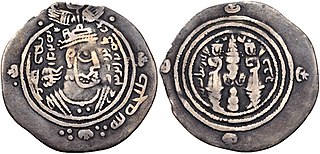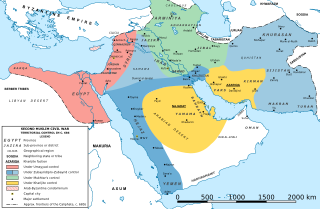Related Research Articles

Mu'awiya I was the founder and first caliph of the Umayyad Caliphate, ruling from 661 until his death. He became caliph less than thirty years after the death of the Islamic prophet Muhammad and immediately after the four Rashidun ('rightly-guided') caliphs. Unlike his predecessors, who had been close, early companions of Muhammad, Mu'awiya was a relatively late follower of Muhammad.
Following the Islamic conquest in 641-642, Lower Egypt was ruled at first by governors acting in the name of the Rashidun Caliphs and then the Umayyad Caliphs in Damascus, but in 750 the Umayyads were overthrown. Throughout Islamic rule, Askar was named the capital and housed the ruling administration. The conquest led to two separate provinces all under one ruler: Upper and Lower Egypt. These two very distinct regions were governed by the military and followed the demands handed down by the governor of Egypt and imposed by the heads of their communities.

Marwan ibn al-Hakam ibn Abi al-As ibn Umayya, commonly known as Marwan I, was the fourth Umayyad caliph, ruling for less than a year in 684–685. He founded the Marwanid ruling house of the Umayyad dynasty, which replaced the Sufyanid house after its collapse in the Second Fitna and remained in power until 750.

Abd Allah ibn al-Zubayr ibn al-Awwam was the leader of a caliphate based in Mecca that rivaled the Umayyads from 683 until his death.
Uqba ibn Amir al-Juhani was a companion of the Islamic prophet Muhammad and the Umayyad governor of Egypt in 665–667 and died in the province.

The Second Fitna was a period of general political and military disorder and civil war in the Islamic community during the early Umayyad Caliphate. It followed the death of the first Umayyad caliph Mu'awiya I in 680, and lasted for about twelve years. The war involved the suppression of two challenges to the Umayyad dynasty, the first by Husayn ibn Ali, as well as his supporters including Sulayman ibn Surad and Mukhtar al-Thaqafi who rallied for his revenge in Iraq, and the second by Abd Allah ibn al-Zubayr.
Ubayd Allah ibn al-Habhab al-Saluli was an important Umayyad official in Egypt from 724 to 734, and subsequently Umayyad governor of Kairouan, Ifriqiya from 734 to 741. It was under his rule that the Great Berber Revolt broke out in the Maghreb and al-Andalus.
Hanzala ibn Safwan al-Kalbi was an Umayyad governor of Egypt from 721 to 724 and again 737 to 742, and subsequently governor of Ifriqiya from 742 to 745.
ʿAbdallāh ibn ʿAbd al-Malik ibn Marwān was an Umayyad prince, the son of Caliph Abd al-Malik ibn Marwan, a general and the governor of Egypt in 705–709.
Abd al-Aziz ibn Marwan ibn al-Hakam was the Umayyad governor and de facto viceroy of Egypt between 685 and his death. He was appointed by his father, Caliph Marwan I. Abd al-Aziz's reign was marked by stability and prosperity, partly due to his close relations and reliance on the Arab military settlers of Fustat. Under his direction and supervision, an army led by Musa ibn Nusayr completed the Muslim conquest of North Africa. He was removed from the line of succession to the caliphal throne and, in any case, died before his brother, Caliph Abd al-Malik. However, one of Abd al-Aziz's sons, Umar, would become caliph in 717.
The Battle of Marj Rahit was one of the early battles of the Second Fitna. It was fought on 18 August 684 between the Kalb-dominated armies of the Yaman tribal confederation, supporting the Umayyads under Caliph Marwan I, and the Qays under al-Dahhak ibn Qays al-Fihri, who supported the Mecca-based Abdallah ibn al-Zubayr; the latter had proclaimed himself Caliph. The Kalbi victory consolidated the position of the Umayyads over Bilad al-Sham, paving the way for their eventual victory in the war against Ibn al-Zubayr. However, it also left a bitter legacy of division and rivalry between the Qays and the Yaman, which would be a constant source of strife and instability for the remainder of the Umayyad Caliphate.
Sa'id ibn Yazid ibn Alqama al-Azdi was the governor of Egypt for the Umayyad Caliphate in 682–684.
The Umayyad dynasty or Umayyads was an Arab clan within the Quraysh tribe who were the ruling family of the Caliphate between 661 and 750 and later of al-Andalus between 756 and 1031. In the pre-Islamic period, they were a prominent clan of the Meccan tribe of Quraysh, descended from Umayya ibn Abd Shams. Despite staunch opposition to the Islamic prophet Muhammad, the Umayyads embraced Islam before the latter's death in 632. Uthman, an early companion of Muhammad from the Umayyad clan, was the third Rashidun caliph, ruling in 644–656, while other members held various governorships. One of these governors, Mu'awiya I of Syria, opposed Caliph Ali in the First Muslim Civil War (656–661) and afterward founded the Umayyad Caliphate with its capital in Damascus. This marked the beginning of the Umayyad dynasty, the first hereditary dynasty in the history of Islam, and the only one to rule over the entire Islamic world of its time.
Hafs ibn al-Walid ibn Yusuf al-Hadrami was a governor of Egypt for the Umayyad Caliphate in the mid-8th century.

Abu Marwan Bishr ibn Marwan ibn al-Hakam was an Umayyad prince and governor of Iraq during the reign of his brother, Caliph Abd al-Malik. Bishr fought at Marj Rahit with his father, Caliph Marwan I. Marwan posted Bishr to Egypt to keep his brother Abd al-Aziz company. In 690/91, Bishr was made governor of Kufa and about one year later, Basra was added to his governorship, giving him full control of Iraq.
Abu Umar Muhammad ibn Yusuf al-Kindi was a prominent Arab historian, genealogist, and hadith scholar. He studied under the most famous hadith scholar of his time, imam al-Nasa'i.
Abu Umayya Amr ibn Sa'id ibn al-As al-Umawi, commonly known as al-Ashdaq, was a member of the Umayyad dynasty, general and a contender for the caliphal throne. He served as the governor of Medina in 680, during the reign of Caliph Yazid I and fought off attempts by the Zubayrids to conquer Syria in 684 and 685 during the reign of Caliph Marwan I. The latter removed Yazid I's son Khalid and al-Ashdaq from the line of succession in favor of his own sons Abd al-Malik and Abd al-Aziz. Al-Ashdaq's attempted coup against Abd al-Malik in 689 ended with his surrender and his execution by Abd al-Malik.
Utba ibn Abi Sufyan ibn Harb was a member of the Umayyad ruling family and served as the Umayyad governor of Egypt in 664–665, during the reign of his brother, Caliph Mu'awiya I.
ʿAbd Allāh ibn Yazīd ibn Muʿāwiya ibn Abī Sufyān, commonly known as al-Uswār, was an Umayyad prince from the Sufyanid line of the dynasty. He was the son of Caliph Yazid I. After the death of his brother, Caliph Mu'awiya II, in 684, he and his brother, Khalid ibn Yazid, were deemed too young to succeed by the pro-Umayyad tribes of Syria and Umayyad rule was vested in the line of a distant kinsman, Marwan I. Abd Allah was a famed archer and horseman and commanded part of the army which took over Iraq from anti-Umayyad forces during the Second Fitna in 691.
Abd al-Malik ibn Umar ibn Marwan ibn al-Hakam, also known as al-Marwani, was an Umayyad prince, general and governor of Seville under the first Umayyad emir of al-Andalus, Abd al-Rahman I. He led two major campaigns in 758 and 774, the first against the previous ruler of al-Andalus Yusuf ibn Abd al-Rahman al-Fihri and the second against the rebellious troops of Seville and Beja. His victories solidified the Umayyad emirate's control of western al-Andalus. His descendants continued to play important political and military roles in the Emirate well into the 10th century.
References
- ↑ Kennedy 1998, p. 70.